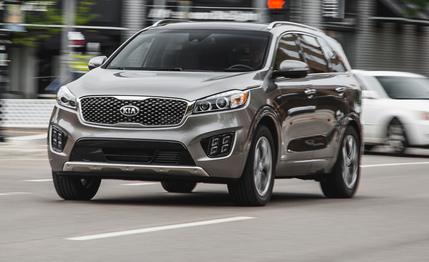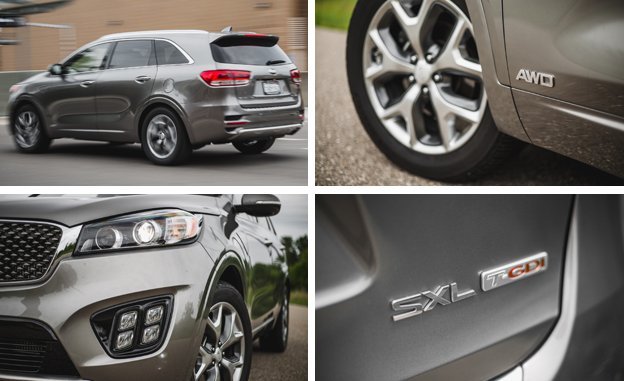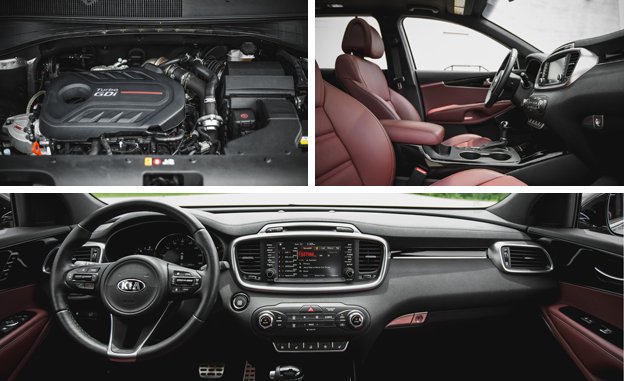
 Instrumented Test
Instrumented Test
It used to be rare that we’d test a four-cylinder vehicle that cost more than the same model equipped with a V-6, but that’s becoming more common—and it’s what we have here: a loaded Kia Sorento SXL for $45,095, fully 10 percent pricier than the V-6 AWD edition tested previously. This four, though, isn’t the base engine—it’s the 240-hp turbocharged 2.0-liter found in the EX and in this SXL (for “SX Limited”) trim level. It generates more torque at lower rpm than does the 290-hp 3.3-liter V-6, while squeezing an extra 2 or 3 miles out of each gallon of regular unleaded gasoline, according to the EPA ratings. Like all Sorentos, it features a six-speed automatic.
Bracketing the V-6 at the lower end of the lineup is a second four-cylinder, as the base Sorento L and LX make do with a normally aspirated 2.4-liter rated at 185 horsepower; the upside to the base engine is that it returns the best EPA ratings. Generally speaking, all the four-cylinder models—turbo or non-turbo—are two-row crossovers while the V-6 versions (LX, EX, SX, and SXL) add a tiny third-row seat. There’s only one way to get three rows in a four-cylinder: The LX with the base engine offers the third row as an extracost option.


While opting for the turbocharged four instead of the V-6 looks like a straight-up exchange of 50 horsepower for 3 mpg in the EPA-combined rating, the real-world situation is a little more nuanced. Our V-6 test car was in the SX trim, which is not available with the turbo and is one step down from the SXL we drove here, and the six weighed 136 pounds more on our scale.
At the track, this turbo four trailed the V-6, taking 8.0 seconds to hit 60 mph versus 7.2, but the gap narrowed in the quarter-mile, this model doing 16.2 seconds at 87 mph as compared to 15.7 at 90. Full-throttle drag racing probably won’t figure into most buyers’ lives with a car like this; a more telling figure may be the midrange passing times. Both versions took 3.9 seconds from 30 to 50 mph, and from 50 to 70 mph the V-6 at 5.1 seconds beat the turbo four by only a tenth. In routine city and highway driving, we never missed the six-cylinder’s power, perhaps because the turbo four’s peak torque comes on strong at only 1450 rpm.
The four turns out to be the quieter engine, too. Flooring the pedal in the V-6, which needs to rev harder to make torque and lacks the muffling effect of a turbo, generates 76 decibels compared with only 72 in this car. A subjectively coarser texture to the four-cylinder’s idle, one we felt more than heard, perhaps also turned up in the sound measurement, where the six held a slight advantage.
On the same Michelin tires and 19-inch wheels, our turbo four and V-6 Sorentos recorded an identical 0.80 g of lateral acceleration, not bad for this class where we still see a lot of crossovers in the low- to mid-0.7-g range. On the road, the Sorento is competent and assured without feeling particularly eager in cornering maneuvers. Kia brags about the rack-mounted electric-power-steering motor on upper trim levels (lesser versions mount the motor to the steering column). There’s a definite improvement in steering feel and response over the previous-generation Sorento, but it’s still not as lively or communicative as we’ve found in European-brand crossovers.
At 183 feet from 70 mph, braking took a little longer in this car than in the V-6 and we measured slight fade over repeated stops; the V-6 stopped in 179 feet with no fade. There’s no mechanical difference in the brakes, but the turbo model’s weight balance tilts slightly more toward the front axle.
One number that might sway some toward a V-6 version is its 5000-pound tow rating in all-wheel-drive form. The 2.0-liter turbo can pull 3500 pounds in front- and all-wheel-drive editions (same as a FWD V-6), while Kia says the base 2.4-liter is good for 2000 pounds.


The other number that matters is the sticker price, and here we should note this SXL brings a lot of standard content, giving up nothing to the SX V-6 and adding a heated steering wheel, nappa leather seats, heated and ventilated front seats, and a heated second row. Our test example was also equipped with the optional ($2500) Technology package, which includes xenon headlights, lane-departure warning, forward-collision warning, an electronic parking brake, adaptive cruise control, and a surround-view monitor. So, yes, it’s a $45,000 Kia, but it has a lot of the same features that you’d find in luxury-brand crossovers in the $50,000-to-$60,000 territory.
And, as our earlier test found, both the exterior and interior design and execution are to a high standard. You’re not likely to be coddled as much by a Kia dealer as by one for a luxury brand such as Lexus or Audi, but once you’re behind the wheel enjoying the comfortable leather seating and the telematics and infotainment features, $45K starts to look like a bargain. Even for those who find the loaded-up version too pricey, the new Sorento offers a solid, competent chassis and powertrain in a quiet, comfortable vehicle. Shop carefully—the content in the trim levels varies depending on whether you’re getting the V-6 or the turbo four, and front- or all-wheel drive. But like us, you may find this turbo four to be the Sorento of choice.